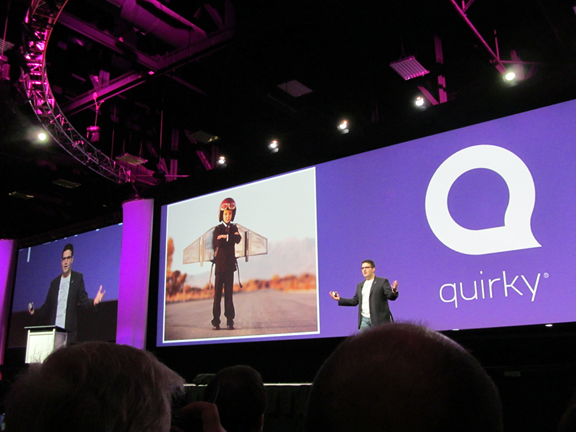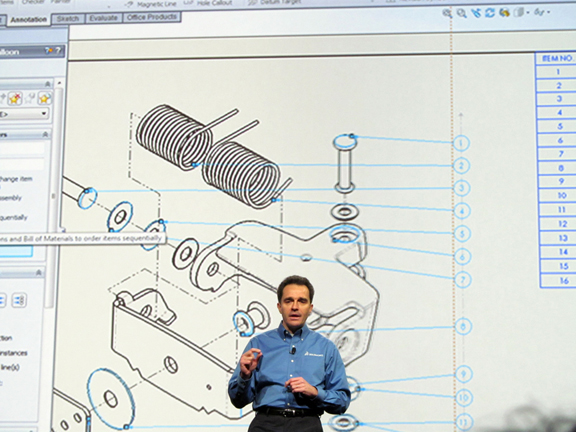Latest News
February 17, 2012
On Tuesday February 14, Day Two of SolidWorks World 2012, a young man with a boyish grin and a quirky pair of glasses stepped up to the stage inside San Diego Convention Center. Ben Kaufman, CEO of Quirky, is an enabler, the patron saint of garage-dwelling inventors looking for a break. He believes we humans are, by nature, addicted to invention. We can’t help it.
“We as a people must invent, not because we need to find new ways to make money, or to showcase our intelligence, but because it’s part of who we all are,” he declared, in a video clip that outlines Quirky’s manifesto.
Have a bright idea for a product? Need help fleshing out your brainchild into a merchandize? Kaufman’s company, which operates an online product-development community, may be the midwife you need.
“Since launching in 2009, Quirky has rapidly changed the way the world thinks about product development,” Quirky explains its mission. “We bring two brand new consumer products to market each week, by enabling a fluid conversation between a global community and Quirky’s expert product design staff.”
As a member, you submit your ideas to the Quirky community. A flower-shaped power plug? A charging station shaped like a globe? A remote-controlled bulldozer and dustbin to trick your kids into doing your cleaning chores? Whatever your idea is, it’ll be peer-reviewed, rated, sorted, voted, and refined by the community. Come Friday, two of the designs submitted are adopted by Quirky. That’s where the fun begins.
If your idea is picked, Quirky puts its own team of industrial designers to work to turn your concept into a product. “Our facility allows us to prototype products the old-fashioned way, or with some of the most advanced 3D printing and micro-manufacturing technologies,” said Kaufman. Perhaps the most appealing part of Quirky’s proposition is, Quirky foots the bill to turn your napkin drawing or CAD model into a real product. And when the product begins selling enough units to turn a profit, Quirky cuts you a check.
One of the Quirky success stories is Jake Zien, who envisioned a circular power-outlet strip. A couple of years ago, Zien was just a kid from Milwaukee, Wisconsin, who majored in graphic design with a computer science minor. Today he is literally cashing in on his invention, dubbed the Pivot Power Strip, brought to market through Quirky. It’s now available online or onsite at Amazon.com, Target, and OfficeMax, among other places.
Quirky represents a new model in product development, driven by openness instead of secrecy, governed by a community instead of a corporate hierarchy. A similar approach is found in Local Motors, which facilitates member-driven automotive design (a process dubbed “cocreation”).
The company explains, “Anyone can join the Local Motors community at www.local-motors.com to assist in designing and engineering of new, innovative, vehicles, and anyone can help choose which vehicles are produced and available for purchase ... Local Motors does not sell kits. Customers get to build their co-created vehicle at the Local-Motors Micro Factory with professional assistance.”
Thriving online communities like GrabCAD (launched in 2010, now houses 25,000+ CAD models, exchanged by 102,000+ users) have shown that designers and engineers are not reluctant to exchange ideas and share concepts. They are collaborating—without the enterprise collaboration tools that often hamper collaboration.
Hinting at Changes on the HorizonThis year’s SolidWorks World marked Gian Paolo Bassi’s first official appearance as the company new point man for research and development. As successor to long-time SolidWorks veteran Austin O’Malley, Bassi will oversee the development of future releases of SolidWorks. (For more on Bassi, read “SolidWorks in Transition,” October 12, 2011.)
During his meeting with the press, Bassi noted, “Design software are great at modeling something precisely for manufacturing, but not so good for capturing early concepts.” He’s hinting at the possibility of a more flexible 3D modeler with low learning curve, but it’s unclear whether it’ll come in the form of a direct modeler or something else entirely new.
As SolidWorks 2013 goes into development, some wondered if SolidWorks would change its modeling kernel, from its current Parasolid kernel (licensed from competitor Siemens PLM Software) to something else based on parent company Dassault Systemes’ technology. But on the third day of the conference, Fielder Hiss, SolidWorks’ VP of product marketing, explicitly said, “SolidWorks kernel is NOT changing.”
In November, responding to the discussion thread “Rumors of a Kernel change in SolidWorks…is this true?,” SolidWorks social media manager Matt West clarified, “Our next generation software, which will be released in the next few years, will include a different modeling engine than the one we use today. This software will be offered in addition to the software we currently sell. No customers will be forced to move from the current version to this next-gen version. The current version of SolidWorks, which we will continue to develop and support in parallel to the next-gen system, will continue to be based on the Parasolid kernel.”
Whatever the next generation software may be, SolidWorks is promising customers that it’ll be another option, not a choice that’ll be forced upon current SolidWorks users. In his keynote address on Day One, SolidWorks CEO Bertrand Sicot said, “We cannot build the latest platform without the latest technology. We think our next generation [product] is the way to move forward. And we will deliver that next year ... In case you’re wondering, we’re going to continue to invest in developing [current SolidWorks software] until you tell us you don’t need it anymore—with no change in the data format. When our next generation [product] is ready, you’ll be able to choose which application you want to use. No one will be forced to migrate to the new platform. And when you do choose to switch, we will make sure the transition is seamless.”
In recent years, SolidWorks’ major rivals—Autodesk, Siemens PLM Software, and PTC—have moved ahead considerably with direct-editing technologies and mobile apps while SolidWorks remained on the sideline. SolidWorks’ next generation technology—the dark horse coming from SolidWorks, currently still hibernating in its R&D stable—has a heavy burden on its shoulder. It must not only catch up with but bypass what its competitors have done.
Subscribe to our FREE magazine, FREE email newsletters or both!
Latest News
About the Author
Kenneth Wong is Digital Engineering’s resident blogger and senior editor. Email him at [email protected] or share your thoughts on this article at digitaleng.news/facebook.
Follow DE







